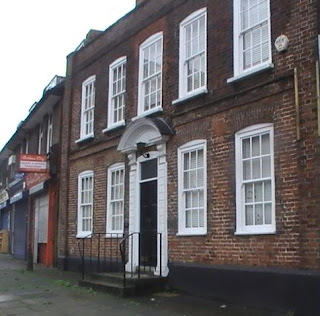 |
| Queenscroft, 2013 |
And not for the first time I am struck by one of the major differences between Eltham where I grew up and Chorlton cum Hardy where I have lived for the last 37 years.
Both were small rural communities on the edge of big cities, and both were seen by those with money as a good place to live.
But Chorlton had fewer of those big fine houses and all of them have now vanished save two modest properties unlike Eltham which had more and has been lucky enough to keep many of them.
During the last century most of them have changed their use but they are still there.
 |
| A once elegant home |
Today the property is not seen at its best.
It is sandwiched between other properties and is close to the road, so that the only way to fully take in its splendour is to stand on the opposite side of Eltham Hill and gaze at it between passing traffic.
But just a century ago it was still set well back from the highway behind a stone wall and sixty years earlier commanded fine views at the rear across open land.
To the east and behind the house was an orchard and then just fields all the way down to the Palace.
 |
| Queens Croft in 1909 with garden wall and orginal spelling |
At the turn of the last century it was occupied by a Colonel Tasker and then by Lieutenant Edward Beddington and his wife Elsie, their two young sons and five servants.
In 1911 Lieutenant Edward Beddington was 27 and an officer in the 16th Lancers and according to his military record was one of the “Old Contemptibles” who had fought in the opening months of the Great War in France. Unlike so many of the British Expeditionary Force he survived the war and retired as a Lieutenant Colonel and died in 1926.
In time it should be possible track most of the families of Queenscroft over the last two centuries, and one has already come to light.
 |
| Looking east up the hill with the church in background |
In that year John who was a wine merchant is listed as paying land tax in Eltham and two years later is in the tithe schedule.
There after he appears in various directories, the 1851 census and the poll book for 1852 which also records that he voted Liberal in the General Election.
He died in Eltham in the January of 1854 and was buried in the parish church Elizabeth his wife survived him by another twelve years.
 |
| Queenscroft in 1874 |
And only today my friend Jean has gone off to check out more of its history including a memory of going there to arrange a visit from the sweep who lived in the place.
So that just leaves the map of the area with Queenscroft in 1870 with the house in red.
Pictures; Queenscroft, 1909, from The story of Royal Eltham, R.R.C. Gregory, 1909 and published on The story of Royal Eltham, by Roy Ayers, http://www.gregory.elthamhistory.org.uk/bookpages/i001.htm
Queenscroft today from the collection of Jean Gammons and map of Eltham from the OS map of Kent, 1858-74
opposite Eltham baths and just short of Queens croft park behind the Gaumont and Eltham hill girls school,
ReplyDeleteHi, you mention Edward Beddington, and that he died between the wars. Actually in WWII he was DDMI, and later worked with my father in SIS and only died in 19966, and was a Brigadier
ReplyDeleteThank you
ReplyDeleteMy grandfather Thomas Stanley Pearce owned the house from 1954 or 55. lived in the house with my parents from that time until my parents emigrated to Australia in 2967
ReplyDeleteMy grandfather Thomas Stanley Pearce owned the house from possibly 1954 till about 1969. I lived in the house with my grand parents and parents from 1954 until they emigrated to Australia in 1967
ReplyDelete